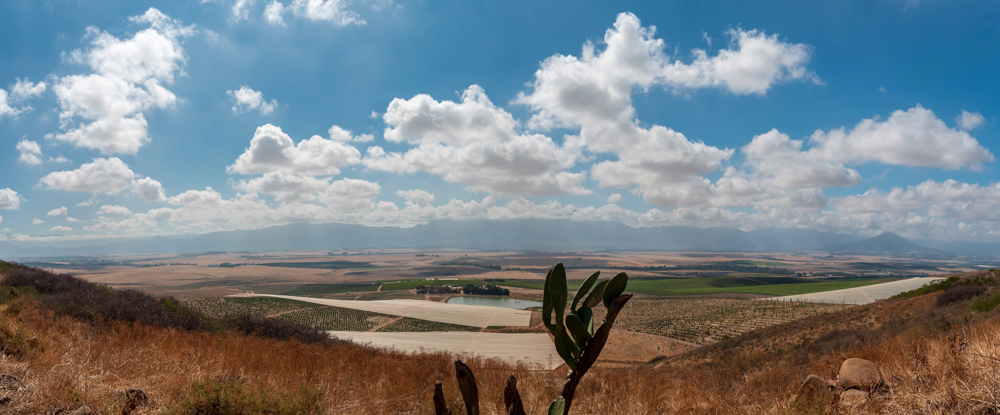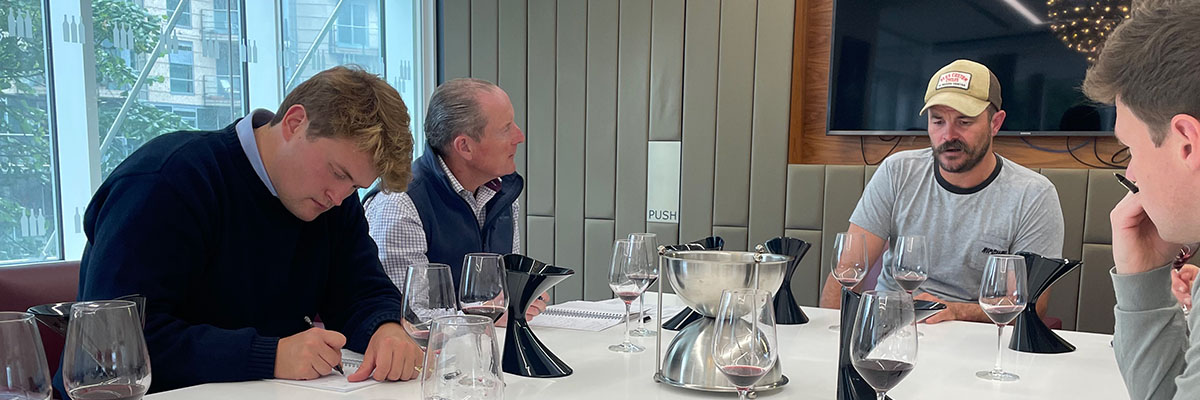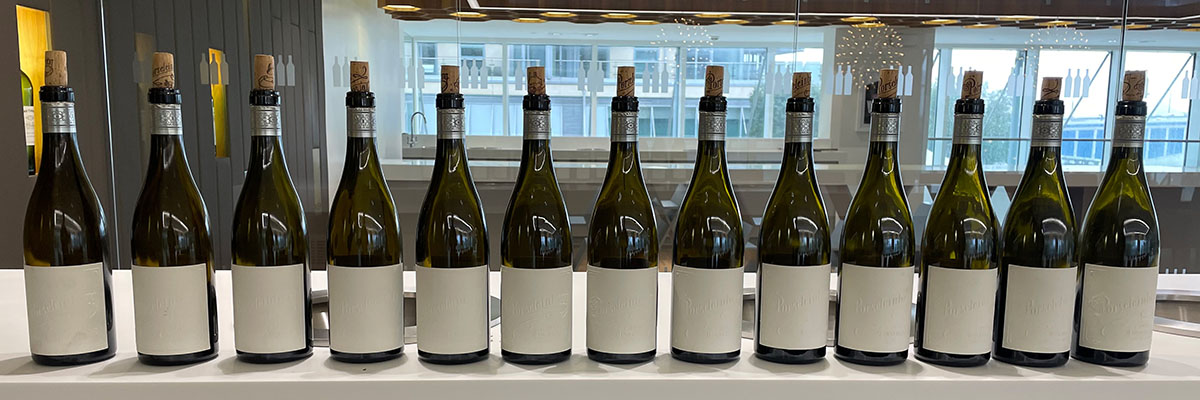
Porseleinberg Syrah has quickly become one of South Africa’s great wines. After Boekenhoutskloof bought the land in Swartland in 2009, they installed Callie Louw as winemaker for the newly acquired vineyards that would produce this unique, brilliant Syrah, and his work over the past 15 years has built Porseleinberg into what it is today. He is reserved but captivating to talk to, though he clearly prefers being among the vines than talking about the wines he produces. It is rare to get a chance to sit down and talk with him, particularly in the UK, so we were delighted to receive him at the Farr Vintners office in September to taste through every vintage he has bottled so far, from the newly-released 2022 back to the 2010.
Above all Callie sees himself as a farmer, half-joking “I stick it in the vat and cross my fingers” when it comes to fermentation: understating his work in all aspects of production as always. The vineyards now have carbon-fixing cover crops to aid the sustainability of the plantations and irrigation is used only where necessary in what is a very dry part of the country. These crops help to reduce the need for water. Callie is conscious to give back to the soil, saying that vinegrowing is a “reductive process”, that the vines take more than they give to produce high-quality fruit, and it is his job to make sure the land gets what it needs. Callie runs through the vines regularly, giving him a connection to the place, saying he often stops to check on the progress of the vines to see what they may need. Heat can be an issue, as can drought, though water at the wrong time has also given them issues with oidium. Organics are in place, but Callie is more focused on wholistic sustainable farming than adhering to a set of rules that don’t consider the specificity of this remote, rocky outcrop of vines.
Boekenhoutskloof acquired the vineyards that formed the early vintages of Porseleinberg in 2009 as part of a series of purchases that turned the producer from sourcing much of their fruit to growing it themselves. Most of the holdings are used to make their bigger brands, but as Callie puts it, “they left 3000 plants for Porseleinberg that I could mess around with”. These vines were planted in the mid-1990s and were the exclusive source for the first three vintages. Vines planted in 2010 started coming on board in 2013, and the site for Porseleinberg is now 16 hectares in size, a tiny percentage of the 180 hectares Boekenoutskloof own.

The style of Porseleinberg has always focused on an unmasked representation of the variety and the site. Callie likes whole-bunch (Jamet is the benchmark for him – he has worked there in the past), and every vintage has used a heavy proportion of stems unless oidium has necessitated some de-stemming. Much like at Jamet, Callie gives the fruit a light crush before fermentation to prevent any carbonic maceration. Light pumpovers were used up to and including the 2017 vintage, with ageing in foudres or concrete to advanced ageing.
Part of Callie’s genius with Porseleinberg is the use of tannic extraction to give freshness – these are not high acid reds but they have a lip-smacking moreishness due to the way he is able to integrate fine, persistent back-end bite in the wines. From 2018 he has added submerged cap fermentation to his arsenal, and as with anything in this remote part of Swartland, Callie had to build the frame himself. He has now constructued several and believes that he is getting better with each try. This submerged cap allows for what he calls a “passive” extraction that causes no abrasions to the skins or stems. It also keeps the cap of skins and stems that would otherwise rise to the top of a fermenter covered in liquid and protected against any oxidation or elevated volatile acidity, which is a real potential issue in the heat of his winery. He runs a few “reverse pumpovers” in these tanks, drawing the bubbling top juice down to the bottom of the tank and keeping movement in the fermentation. In the last few vintages he has blended these submerged cap fermentations with more traditional whole-bunch tanks as these retain the tannic bite that he is looking for in the wines.
The wines we tasted were all remarkable, tracking the progress Callie has made over the years. This was made all the more clear by his frankness when discussing each vintage; his direct honesty and clearly-formed opinions make him an extremely engaging, if reluctant, speaker. We tasted the wines in pairs, which I have discussed below.
2010 & 2011
Though Callie doesn’t feel he really got to grip with the wines until 2012, both the 2010 and 2011 are fantastic. They are wild, savoury and complex, the 2011 having something of a warm-vintage Clape Cornas about it. It was never released commercially as the vintage was damaged by heat; only 1,100 bottles were made so if you ever see one of the bottles subsequently released from their mixed cases, snap up a rare treat.
2012 & 2013
2012 is the first to taste Côte-Rôtie-like. It was another small vintage, just 2,500 bottles, aged for 12 months (rather than 24 for 2011) in concrete. It has a deft purity, a signature tannic bite, and is still brimming with fruit. Quantities jumped in 2013 when the new plantings came on board – albeit only to 6,500 bottles in what was an easy growing season.
2014 & 2015
2014 was the wettest vintage they have had. Mildew reduced volumes and lack of space meant the wines were aged in foudres rather than eggs, but the wine is a fragrant and delicious example. Callie says 2015 was “boring” because it was so easy to farm, with no catastrophes or bad weather to “get the heart going”. The wine is darker, sweeter on the nose, but still fresh on the palate thanks to the tannins, foreshadowing the 2020 in some ways.
2016 & 2017
Drought begins here and lingers for several years. 2016 had a measly 221mm of rain, but from October to picking in March there was just 34mm. They cropped at less than two tonnes per hectare, and Callie thought he wouldn’t be able to make a wine they could sell, and yet this dense, concentrated wine is very impressive. It is perhaps the outlier in the vertical, but it feels like a wine that could age very well. 2017 saw a slight increase of rain to 327mm and it was also slightly cooler. This was the first vintage Farr Vintners sold from release, and it remains a brilliant wine. The vines were stunted by the previous year's lack of rain, producing concentrated berries. To me this wine speaks loudest in representing what Porseleinberg is, something we see again in some of the newest releases.
2018 & 2019
2018 was the first submerged cap vintage and the wine shows the change – it has a slick texture, sweeter and purer fruit. It is glossy in a way some vintages are not, a real crowd-pleaser. 2019 is a cool(er) vintage but the vines were tough to farm after three previous years of drought (2018 was only 224mm). The wine however is a marvel, arguably the best vintage at Porseleinberg. It takes all the character of 2017 and just a pinch of gloss from 2018 to make something unique, perfumed and perfectly balanced.
2020 & 2021
Callie described the 2020 as a vintage with "no drama", much like the 2015, and the wines share the easy gloss, precise fruit and more supple textures that signify the ease of the growing season. This can be drunk now, but I expect it will gain considerable complexity with bottle age. The 2021 has blossomed beautifully in the last 12 months, warranting a higher score than I initially gave it. Callie is not big on picking favourites but when pressed he thinks this and the 2017 are the best he has made. There are signs of the rugged, wild vintage but also the added polish and cool fragrance of 2019 in this wine. Picks started at a potential 12.8 abv and ended at 14.5, giving an array of flavours and a final alcohol below 14%. Conventional whole-bunch fermentations came back in this year to marry with the submerged cap wines and it is this soul and bite on the back end that, to me, really elevates this vintage. A stellar wine and one to watch as a future great.
The rains came in just the right volumes up until December for this vintage, and were desperately needed as the sun came out and never left, shutting down the vines, slowing maturation and giving Callie some real stress. They picked until mid-March - when they normally finish in February - and ended up with a low (for them) 13.3% abv. Despite the stress for vine and man, the resulting wine is an expressive, soulful Syrah that speaks beautifully of its rugged upbringing. The tannic bite synonymous with the wine is on show but so is the haunting herbal, peppery, gamey fruit that is saved only for the variety's best wines. It is a testament to Callie's work and intimate understanding of what the place needs, and was deservedly named Tim Atkin's South African Wine of the Year.
Thank you to Callie for coming to share both wines and knowledge with our team. Porseleinberg continues to be one of the most exciting projects we follow here at Farr, evolving and improving each year, with each wine having its own intrigue while remaining true to the essence of the site. Tasting notes on all the wines are below.

2010
The first vintage of Porseleinberg. 3,300 bottles made. 40% concrete, 60% foudre. 16 month elevage. This has a ruby-garnet colour and a wild nose of iron filings, coffee, blood and bramble fruits. The palate shows iodine, smoke, leather, rosemary and thyme. A gamey, mature, delicious Syrah that is untamed but fantastic to drink now.
2011
Not released commercially until the vertical cases. Only 1,100 bottles made. 24 months solely in concrete egg. Deeper in colour than the 2010 with a nose of espresso, dark chocolate and oily black fruits. Muscular and concentrated on the palate, there is something of Clape Cornas to this wine. Deep, dark and brooding, there are layers of anise, game and incense. A powerful, chewy Porseleinberg.
2012
Small vintage, 12 month elevage in 3 concrete eggs. 2,500 bottles. This is the first vintage that has a whiff of Côte-Rôtie about it. Bright, juicy and fragrant with blueberry, brambles and pressed flowers. There is a touch of leather and game, dried rosemary and garrigue here too. A clear step in refinement from 2011 to here, with a long, pure finish that still lingers with delightful blue and black fruit together with something savoury and very, very moreish.
2013
13 months in concrete. First vintage to include the new plantings. 6,500 bottles. Smoky - but not in an oaky sense - with layers of chocolate, dried cherries, iron filings and game. This is a pithy, textural wine that really shows the chalky back end freshness that has become one of Porseleinberg's hallmarks. A bold, brambly wine, this is like a purer, more refined version of the 2011 and it clearly still has further capacity to age.
2014
12 months elevage from this vintage onwards. All in foudre. Wettest vintage for Porseleinberg. 6,000 bottles. A wonderful nose, really open and fragrant with dried herbs, pepper, smoked duck and exotic toasted spices. Silky fruit lines the palate, matched by powdery fresh tannins. A deft, lithe and delicious wine, it is at its apex now.
2015
Easy growing season. 8,000 bottles. Deeper in colour than the 2014 with a richer nose of espresso, bitter chocolate, roasted fresh fig and some bacon fat. Straight in structure but bold in fruit, this is an oily wine with a firm bite of tannins and a sense of grandness. It needs more time to relax and mellow, but is a powerful, impressive iteration that retains its fresh tannic lift on the back end. It feels almost like a Chapoutier wine - one that doesn't see lashings of oak - with a real sense of granite weight and potential on the finish.
2016
First of several drought vintages - a year in which people were running out of water. Very low yields. An outlier in this vertical, this opens with an almost Malbec-like sense of sweet, opulent fragrance: violets, blueberries and damsons all come through with cured meats. Syrah-concentrate on the palate - all brambles, pepper, liquorice and dark fruit liqueur. Stern with firm tannic bite on the back end, it is a monolith that still needs time. If it knits together it will be a very impressive mature glass, but for now this concentrated, brooding and dark wine needs food and a decant.
2017
More drought but 50% more rain than in 2016 and cooler temperatures. Foudres with a little concrete. A brilliant wine, the 2017 is chock full of the character that makes Porseleinberg what it is today. Game and dark fruit mix with rosemary, sage and top notes of pressed flowers. The palate follows this profile in flavour, the chalkiness of tannin building to the finish but the fruit matching it all the way. Multi-faceted in its fruit expression, it manages vibrancy and sweetness in a refreshing, moreish manner. Evolving and improving with time in the glass, it is a lipsmacking, gorgeous Syrah that speaks to variety, place and intention of maker. Outstanding.
2018
First vintage to use submerged cap fermentations. Another drought year. Shift back towards concrete. Everything about the 2018 has a real sheen to it: the fruit is glossy, the spiciness sweet and supple, the overarching sense of youthful vigour. The palate is much the same, the typical bite of tannins cloaked in succulent fruit and notes of creamy coffee and chocolate. Absolutely pristine, with jewels of fruit driving the palate to a long, refreshing finish laced with fresh flowers, I expect this wine to improve gracefully in the cellar and have a long, open drinking window.
2019
330mm of rain, but cool temperatures. Stunted vines from multiple drought vintages gave small, concentrated, berries. Perhaps the best wine made at the estate, the nose to the 2019 is immediately engaging, marrying the purity of 2018 with the wild flair of 2017. Vibrant, peppery dark fruit meets a little game and wave upon wave of flowers. There is a little smoky reduction but it is complementary rather than dominating the nose. The palate is elegant yet intense, an explosion of fruits and flowers coating the tongue. The salty, chalky tannins build towards the back end with the hit of rosemary and wild herbs unique to Syrah made in this fashion. There is almost a smoked paprika edge to the fruit, which is as fascinating as it is delicious. This is a triumph, a wine that you can drink now or doubtless in 10-15 years time.
2020
A bit more rain - 400mm. A less concentrated version of the 2015 to Callie's palate. The fruit has amazing purity in this vintage, all cherries, blueberries and blackberries. The palate has a fragrant freshness to it, with a touch of the sheen from 2018. Refined and restrained, this is delicious to drink now. Hints of iron filings and liquorice add some complexity on the back end, together with that chalky signature. There is no need to wait here, this is open-knit and ready to go.
2021
One of Callie's two personal favourites, together with 2017. Long harvest with fruit from 12.8 to 14.5% potential alcohol. Return of some conventional fermentations to give back some tannic bite. This wine has come on leaps and bounds with the extra year in bottle. Initially tight but with a brilliant purity of fruit, with air there are sparks of pepper, game, pressed flowers and flinty, stony earth. The palate is so vibrant, chalky tannins meeting tangy fruits. Focused but with great intensity, this will benefit from more time in bottle but some time in the glass (and then 6 hours of air) reveal just how fantastic a wine this will be in time. That a wine can have such precision and yet be so characterful with a clear sense of place is quite brilliant. It is easy to see why Callie loves this wine - it feels something like the 2017, but with the flair woven into high definition fruit and riper, cleaner, finer tannins. Superb.
2022
Important rains until December, then sun that wouldn't stop before harvest causing the vines to shut down. 13.3% abv as a result. Picking was late, into 10th March, when it usually finishes in February. An open, expressive and already very complex nose. Fragrant with notes of garrigue, sage, rosemary and thyme. This comes together with red cherry and berry fruit and pressed flowers. The palate is just as expressive, precise but with a wild edge like the 2017, 2019 and 2021. There are hints of iron and dried herbs, together with the chalky tannins that give this wine its sense of place. An outstanding wine that you could approach now but will doubtless improve in bottle for over a decade. Brilliant.
